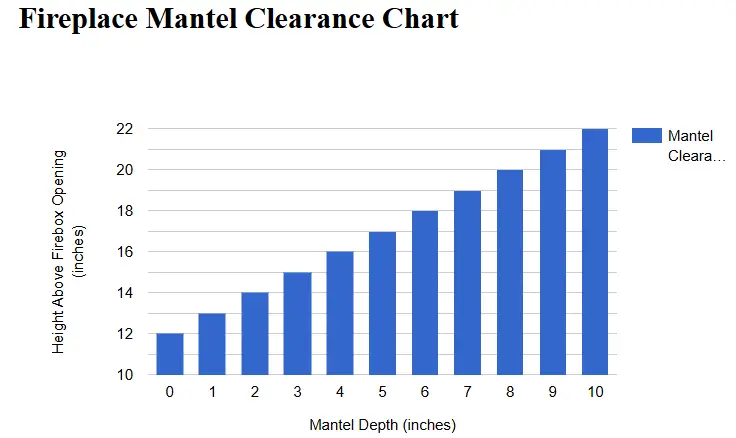Fireplaces are a wonderful addition to any home, providing warmth and ambiance. However, they come with their own set of safety requirements, particularly when it comes to mantel clearance. If you’ve ever wondered how close your fireplace mantel can be to the firebox without risking a fire hazard, you’re in the right place.
In this article, we’ll dive into fireplace mantel clearance guidelines according to national fire codes, why they matter, and how you can ensure your home is safe.
What is Fireplace Mantel Clearance?
Fireplace mantel clearance refers to the safe distance that must be maintained between the fireplace opening and any combustible materials like wood mantels, trim, or shelves.
It ensures that heat emanating from the fire does not ignite nearby materials, which can pose a significant fire hazard.
Mantel clearance is crucial because too-close mantels or decorative elements can absorb excessive heat and potentially catch fire.
How Much Clearance Does a Fireplace Mantel Need?
The clearance a fireplace mantel needs depends on its depth and local building codes. Generally, the mantel should be placed at least 12 inches above the fireplace opening. For every inch the mantel protrudes from the wall, an additional inch of clearance is required. For example, a mantel that is 8 inches deep should be installed 20 inches above the fireplace opening.
Always refer to your local building codes to ensure proper installation and safety.
Fireplace Mantel Clearance Chart
Instructions:
National Standard Building Code Information
2114.3 Masonry-Built Fireplaces (4114.3.10):
When installing a mantel or similar trim around a masonry-built fireplace, it’s essential to follow clearance guidelines for safety. Any combustible mantel or trim must be at least 6 inches away from the fireplace opening.
If parts of the mantel extend more than 1 1/2 inches (38mm) from the fireplace face, additional clearance is required.
For those located above the opening, if they project more than 1 1/2 inches (38mm), they need to be at least 12 inches (305mm) from the top of the fireplace opening.
2806 Factory-Built Fireplaces (2806.1.2):
Factory-built fireplaces must be listed by a recognized testing agency and installed according to the manufacturer’s instructions.
This means you should always consult and follow the fireplace owner’s manual for proper installation, including the mantel’s positioning and safety clearances.
National Fire Code:
The National Fire Code aims to protect homeowners by reducing fire risks. It states that any combustible materials, such as wood mantels or trims, should be kept at least 6 inches away from the fireplace opening.
Additionally, for every 1/8 inch that the material extends beyond the face of the fireplace, an extra inch of clearance is required.
Factors Affecting Fireplace Mantel Clearance
- Material of the Mantel: Wood, being a combustible material, typically requires the greatest clearance. Stone and metal mantels, on the other hand, often need less.
- Mantel Depth: Deeper mantels need more distance from the firebox. The deeper the shelf or mantel, the higher the heat exposure.
- Fireplace Type: Wood-burning fireplaces generate the most heat and therefore require the strictest clearance. Gas fireplaces may have reduced clearance, while electric ones typically need the least.
- Room Design and Ventilation: Poor ventilation can lead to heat buildup, which may affect how close your mantel can safely be to the fireplace.
Fireplace Clearance Chart for Other Combustible Materials
| Item | Minimum Clearance from Fireplace Opening (inches) |
|---|---|
| Wood Trim/Molding | 6 (minimum) for trim, but adjust according to depth, using the same 1 inch per 1/8 inch rule as mantels. |
| Shelves | 12 inches above fireplace opening for shelves up to 1 inch deep, then add 1 inch of clearance for every inch of shelf depth. |
| TV Above Fireplace | At least 20 inches, depending on heat output, with some experts recommending 24-30 inches for larger, heat-sensitive TVs. It’s also advised to use a heat shield or mantel to help protect electronics. |
| Wall Art/Decor | 12 inches above the fireplace for small items, or follow TV clearance guidelines for larger, heat-sensitive artwork. |
| Side Clearances for Combustibles | At least 6 inches from the sides of the firebox opening for trim, bookshelves, or other side flammable objects. Adjust the clearance based on any protrusions as with mantel depth. |
Types of Fireplace Mantels & Considerations
1. Wood Mantels: Special Considerations
Wood mantels are beautiful but require special care. Wood is highly combustible, meaning it needs more clearance from the firebox. To increase safety, ensure that any wood near your fireplace is properly treated and well-maintained to avoid drying out or cracking from heat exposure.
2. Stone and Metal Mantels: Clearance Guidelines
Stone and metal mantels are less susceptible to heat damage and can often be installed closer to the firebox. However, even these materials can absorb and transfer heat, which could cause problems with surrounding materials. Always double-check local fire codes for specifics.
3. Custom Fireplaces and Mantel Clearances
Custom fireplace designs can present unique challenges. If you have a modern or custom-built fireplace, it’s essential to consult with a professional to ensure your mantel is installed at the correct distance.
Customized designs may require specific solutions that adhere to safety codes while maintaining aesthetic appeal.
4. Fireplace Inserts and Mantel Clearance
Fireplace inserts, such as gas or electric inserts, change the way heat is distributed and may alter the necessary mantel clearance.
Check the insert manufacturer’s manual for precise clearance information as these often have less stringent requirements than traditional wood-burning units.
How to Measure Proper Mantel Clearance
-
Use a tape measure to determine the distance from the top of the fireplace opening to the bottom edge of the mantel.
-
If the mantel extends outward, measure the depth and ensure the clearance increases accordingly.
-
Compare your measurements to the appropriate clearance chart or guidelines.
Why Correct Fireplace Mantel Clearance is Important
Failing to maintain proper mantel clearance can result in serious consequences, including:
-
Increased risk of fire
-
Violations of national fire codes
-
Voided insurance claims
-
Potential injury or damage to your property
FAQs
What is the safest clearance distance for a wood mantel?
The NFPA recommends a minimum clearance of 12 inches for combustible materials like wood.
Can I use heat shields to reduce mantel clearance requirements?
Yes, heat shields can sometimes reduce clearance, but this must be approved by local fire codes.
How do I know if my fireplace is up to code?
You can check NFPA 211 standards or hire a certified inspector to assess your fireplace.
Are electric fireplaces subject to the same clearance rules?
Electric fireplaces typically require less clearance, but it’s important to follow the manufacturer’s guidelines.
Can I install a TV above my fireplace mantel?
Yes, but it must be done with careful consideration of heat and clearance requirements to avoid damage.

Affiliate Disclosure: Fireplaceadviser.com is a participant in the Amazon Services LLC Associates Program. We may earn a commission when you click on certain links on this site and purchase.

Hello!! I am Jamal Khan. I often fix my home electric heaters and gas stove problems and research the common issues in the heating units to improve my knowledge and expertise. The aim of establishing fireplaceadviser.com is to share my expertise and knowledge with my audience.









